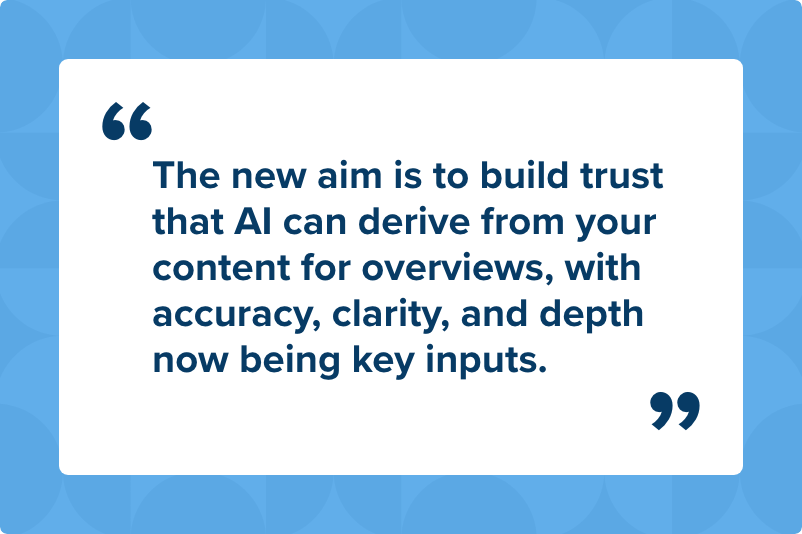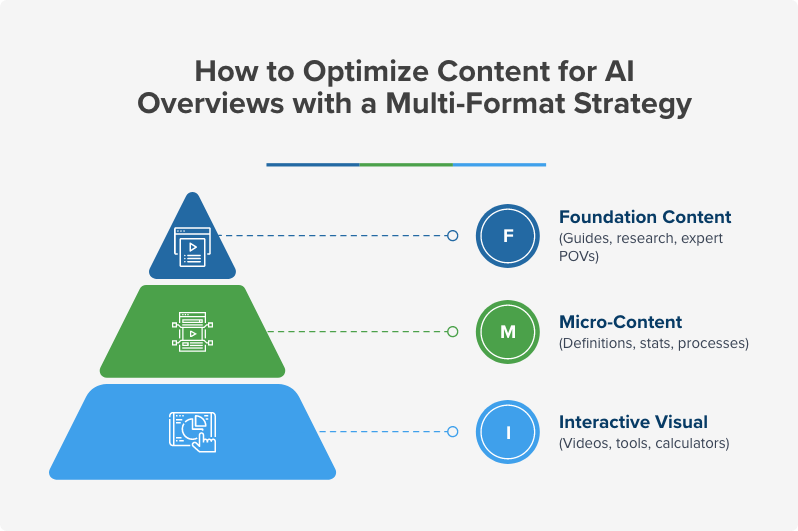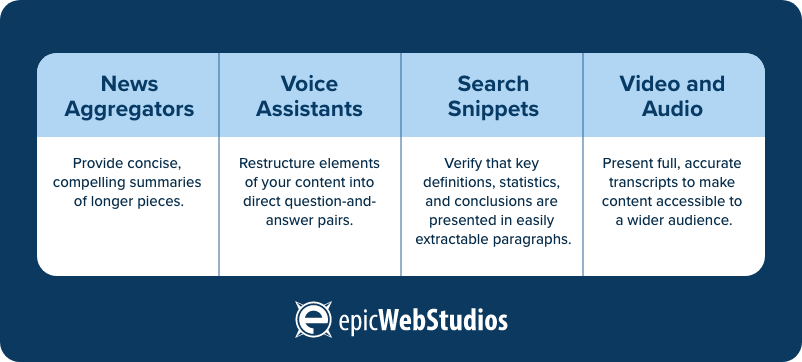We currently stand at a crossroads, where traditional content strategy methods are being reshaped by the rise of zero-click searches and AI-generated summaries. This new reality presents a kind of paradox; we are now tasked with crafting narratives that not only resonate with human users but also speak the language of sophisticated AI systems.
The days when a top-ranking organic link guaranteed a click are fading, with AI increasingly satisfying user intent directly on Search Engine Results Pages (SERPs). Consequently, learning how to optimize content for AI overviews is the only realistic path forward.
But don't start panicking yet! This isn't a doomsday scenario for content. The changing ecosystem is, in fact, a tremendous opportunity in disguise. By embracing content diversification, we can move beyond merely surviving to truly thriving in the digital space.
Understanding "Search Everywhere" Optimization

At its core, AI has become the new gatekeeper of information. Generative AI engines are no longer just indexing content; they are synthesizing, summarizing, and presenting it directly to users, also known as Generative Engine Optimization (GEO).
Unlike traditional Search Engine Optimization (SEO), it's less about simply having a keyword on a page and more about demonstrating comprehensive expertise on a topic across platforms. The new aim is to build trust that AI can derive from your content for overviews, with accuracy, clarity, and depth now being key inputs.
In a world where machines are doing the initial heavy lifting of information delivery, being explicitly referenced by these engines is everything. It's a stamp of authority, a signal of credibility that not only elevates a brand's immediate search results but also reinforces a site's trustworthiness to both search engines and human users.
How to Optimize Content for AI Overviews with a Multi-Format Strategy

A singular content approach is no longer sufficient. That's where a multi-format content strategy comes in, designed specifically to cater to both the demands of AI and the needs of human users simultaneously. This approach inherently supports diversified content for broader reach.
Authoritative Foundation Content
These are the comprehensive, in-depth resources that establish topical authority and provide a reservoir of information for AI to draw upon. This includes:
- Long-form, comprehensive guides that dive deep into a subject, covering all its facets. Guides should always be meticulously researched and structured to demonstrate a thorough understanding of the topic, making them ideal for AI synthesis.
- Primary research and original data sets are invaluable when learning how to optimize content for AI overviews. Content backed by proprietary studies, surveys, and data positions a brand as a viable source of information.
- Expert interviews and thought leadership pieces bring unique perspectives and unparalleled credibility. Depending on your industry, this might mean featuring industry leaders, subject matter experts, or internal specialists to add a layer of authority.
Micro-Content
As the name implies, micro-content is a concise, highly digestible piece of information designed for quick extraction by AI:
- Quotable insights and statistics are bite-sized, verifiable facts or impactful statements that AI can easily pull to answer specific questions within its summaries.
- Definitions and explanations of key terms or concepts provide clear answers to direct queries. Crafting these as precisely as possible increases the chance of them appearing as definitive explanations in AI overviews.
- Step-by-step processes and frameworks are highly valuable, as AI often summarizes relevant "how-to" information. Delineated steps or established methodologies are easy for AI to interpret, making this content a go-to source for actionable advice.
Interactive and Visual Assets
While not always directly cited as text, these formats boost user engagement, reinforce authority, and support the overall perceived value and shareability of content. Interactive elements indirectly influence AI by demonstrating a high-quality user experience (UX):
- Infographics and data visualizations distill complex information into easily digestible and shareable formats. They present data in a clear, compelling way that can be understood at a glance.
- Interactive tools and calculators provide practical value to users, encouraging longer dwell times and repeat visits. Incorporating such tools also demonstrates a brand's commitment to solving user problems, which signals quality to search algorithms.
- Video content and multimedia experiences offer a rich, engaging way to convey information. Videos can either explain concepts, demonstrate processes, or provide expert commentary.
What Content Formats Do AI Systems Cite?
To maximize your content's potential for AI overviews, the next step is to understand the types of formats and structures that these systems are most adept at processing.
Information Assets
AI thrives on clarity and organization. Content presented in easily parsed, structured formats is highly valuable for direct citation. Consider developing and optimizing:
- FAQ sections optimized for voice search directly address common user questions (often in a conversational tone), which aligns perfectly with how AI processes natural language queries. Explicitly stating questions and providing concise, direct answers makes them ideal for AI to pull as immediate responses.
- Comparison tables lay out pros, cons, features, and specifications. These are highly digestible for AI, allowing it to quickly identify and present differentiating factors.
- Glossaries and resource libraries offer definitive explanations that can be directly cited when users search for specific terminology or need a quick overview of a concept.
Data-Driven Content
Statistics and verifiable findings lend immense credibility to your content, a quality highly prized by AI systems for trustworthiness. Focus on creating:
- Industry reports and trend analyses contain content rich with original data, benchmarks, and forward-looking insights, positioning your brand as a leading authority. AI systems prioritize well-researched reports for broader trends as well as factual summaries.
- Survey results and benchmarking studies present proprietary studies that provide citable facts to distinguish your content. AI tends to favor content that offers new, verifiable information directly from a source.
- Case studies with measurable outcomes (i.e., "Company X increased sales by 30% using Y strategy") are highly attractive to AI for demonstrating practical application and impact. Here, a concrete cause-and-effect makes them easily citable.
- Real-time data and live updates provide frequently updated or live data feeds (think stock prices, weather updates, breaking news summaries) that can be invaluable to AI, which aims to provide the most current information available.
Expert-Backed Content
AI is constantly getting better at assessing the credibility of information. So, if you want your content to be trusted (and therefore, cited), your goal is to signal that your brand is founded on expertise and authority. Aim to include:
- Professional credentials and author bios display the qualifications, experience, and affiliations of your content creators or featured experts.
- Industry testimonials vouch for your content; it acts as a strong signal of authority that AI will interpret as a mark of quality.
- Peer-reviewed information that has undergone a peer-review process (or is based on such research) is considered highly credible.
- Multi-expert roundtables bring together multiple experts to discuss a topic, demonstrating a balanced perspective, reinforcing its authority, and making it a richer source for AI to draw from for differing viewpoints.
How to Optimize Content for AI Overviews with Technical Implementation
Even the best content can get lost if AI can't properly "read" it. It's not only what you say, but how you present your brand's information.
Advanced Schema and Markup
Schema markup (or structured data) is the language that explicitly tells search engines and AI systems what your content means in the most literal sense. A few examples include:
- FAQ schema for question-based queries explicitly labels questions and their answers, making your content ideal for direct answers in AI overview as well as "People Also Ask" sections.
- How-to schema for process content clearly outlines each stage of a process, allowing AI to easily extract and present structured instructions.
- Implementing "Organization" and "Person" schema for your brand helps AI understand who is behind the information. This notably strengthens Google's E-E-A-T (Experience, Expertise, Authoritativeness, Trustworthiness) signals, increasing the likelihood of citation from trusted sources.
Content Architecture
The way your content is structured on the page impacts AI's ability to process and understand it. As you explore how to optimize content for AI overviews, remember to include:
- Clear heading hierarchies and content structure create a logical, organized flow that helps AI understand the main topics and subtopics of your content.
- Scannable bullet points and numbered lists provide concise, digestible nuggets of information that are ideal for inclusion in generated overviews or direct answers.
- Table formatting for comparative data ensures your comparative data (features, pros/cons, specifications) is presented in well-formatted HTML tables.
- Alt text and captions for multimedia (images, videos, graphs) give AI a fuller grasp of your visual elements.
Strategies to Diversify Content

Your content's reach extends far beyond your website. This is why cross-platform content is now a necessity to ensure your valuable insights are discovered and cited across the entire digital ecosystem.
Omnichannel Distribution
Make certain your content is available wherever potential users and AI systems might encounter it. An omnichannel approach significantly broadens your content's footprint, making it more likely to be identified as an authoritative source.
Consider utilizing social media platforms, not merely for sharing, but as unique environments for publishing micro-content, visual summaries, or direct insights tailored to each platform's experience.
Actively engaging in industry-specific communities is also key, sharing relevant portions of your content where your target audience and specialized AI systems gather. In this case, you're looking to position your brand as a helpful expert, not just a marketer.
Format Adaptation
Naturally, one size does not fit all. This is how to optimize content for AI overviews across different platforms, depending on how each specifically consumes information.
While adapting formats for distribution, your brand voice must remain consistent. To do this, use a style guide that lays out a specified tone as well as a general formatting formula to follow. Every piece of content (regardless of platform) should reinforce your core value and expertise.
Measuring Success in the New Paradigm
The old rulebook for measuring content success has been rewritten. In a zero-click world, marketing professionals must now adopt a more sophisticated approach, evolving existing metrics and embracing new indicators to truly understand content performance.
Traditional Metrics Evolved
- Click-through Rates (CTRs) suggest a particularly compelling teaser or a user seeking deeper validation beyond the summary. Analyzing these specific CTRs provides insight into the effectiveness of your engagement hooks.
- Brand mention tracking monitors how frequently (and in what context) your brand is mentioned within AI overviews, offering a direct measure of your content's footprint.
- Share of Voice assesses how often your brand or content is cited compared to competitors within the AI overview space for relevant queries.
New Success Indicators
- Citation frequency and context track how often your content is specifically referenced or linked as a source, as well as the quality of that citation. Is it positioned as the primary authority, or just one of many? Is the context positive and accurate?
- Brand recall metrics may be used to measure how well users recognize your brand after encountering your content in AI overviews.
- User journey mapping is necessary to connect initial AI interactions to subsequent actions, providing a complete picture.
How to Optimize Content for AI Overviews: Actionable Next Steps
To kickstart your journey, here's a focused 30-day plan covering exactly how to optimize content for AI overviews and zero-click engagement.
Zero-Click Engagement Tips
✔️ Naturally include your brand name, products, or unique methods in high-value content for AI snippets.
✔️ Be sure that all multimedia (infographics, videos, interactive elements) feature clear, consistent branding for recognition.
✔️ Use a consistent tone and message across all content to build brand familiarity.
✔️ Offer high-level info for AI, but keep deeper insights/details exclusive to your page to compel clicks.
✔️ Integrate tools, calculators, quizzes, or complex visualizations that AI can't replicate, making a click essential.
✔️ Encourage user-generated content and discussions; these unique interactions often require direct visits.
✔️ Provide tools, templates, or databases unique to your site, making your page the only access point for their full value.
GEO Success Starts Here

The long-term goal in an AI world is clear: create strong, trustworthy, and well-organized content. This won't just get you into AI overviews; it will build a stronger, more recognizable brand for the future.
Ready to lead the change? The Epic Web Studios team specializes in helping businesses of all trades and sizes navigate this new landscape. Contact us today to begin transforming your content strategy for the AI era!


